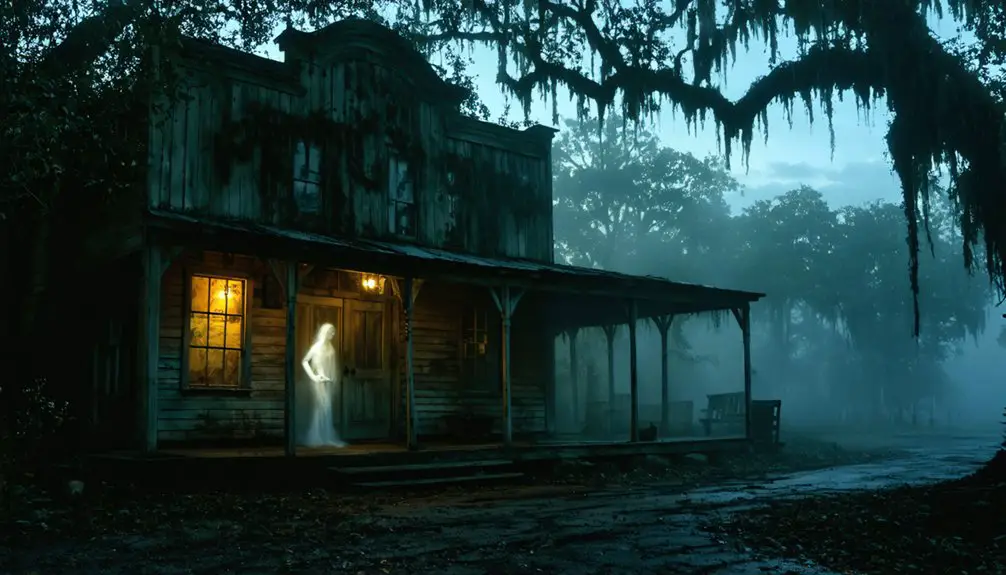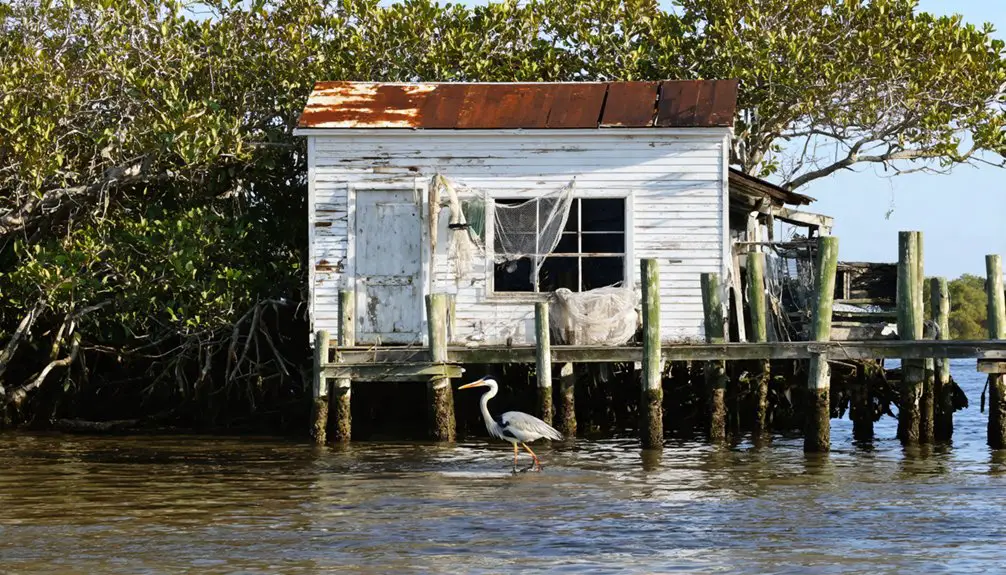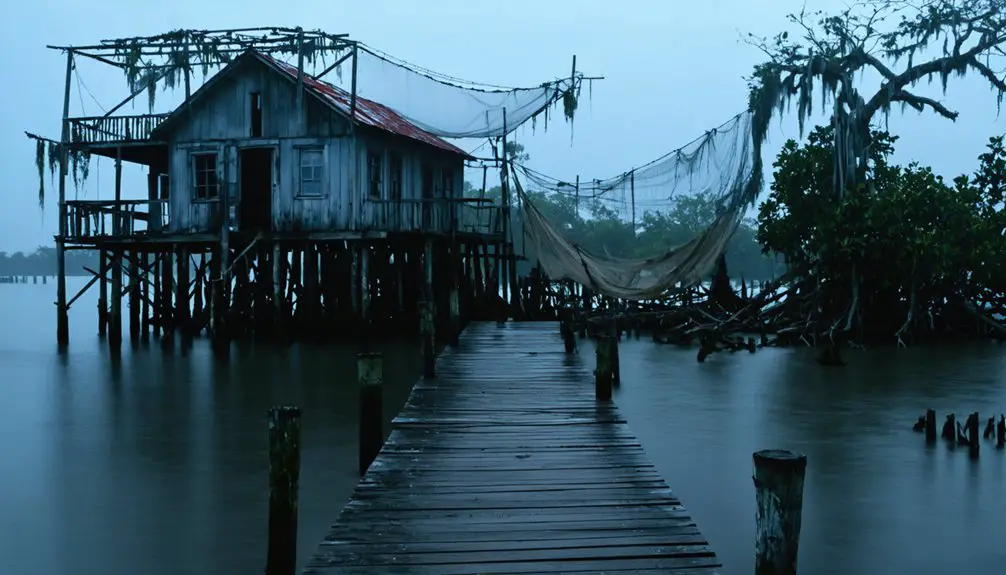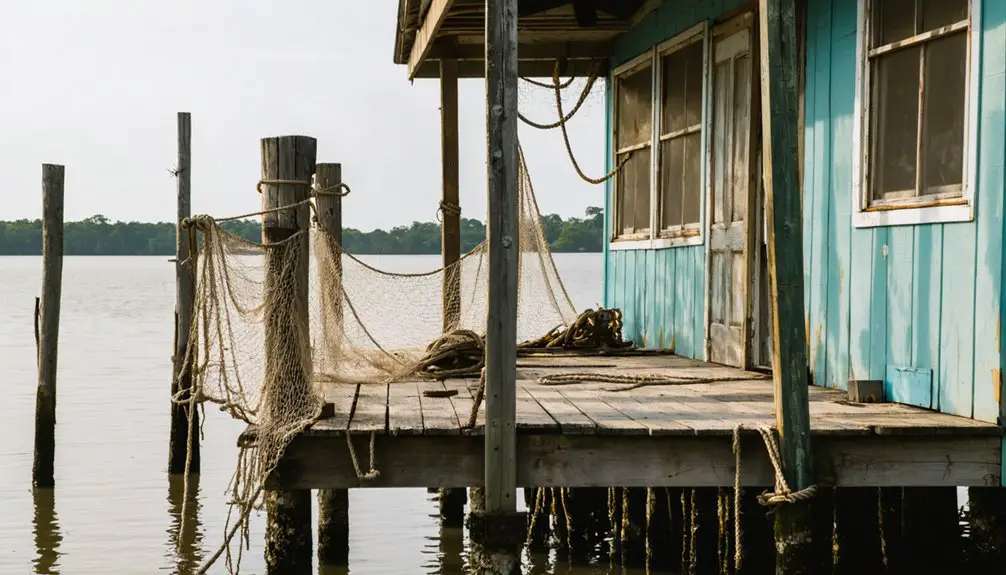You’ll find Chokoloskee on a 150-acre shell mound rising from Florida’s Ten Thousand Islands, where outlaws and fugitives once sought refuge. This former trading post paradise, anchored by Ted Smallwood’s Store in 1906, witnessed the dramatic 1910 vigilante execution of notorious resident Edgar Watson. Today, the preserved store-turned-museum harbors compelling paranormal activity, from mysterious shadow figures to unexplained equipment failures. The weathered walls of this historic outpost hold darker secrets yet untold.
Key Takeaways
- Chokoloskee is not technically a ghost town but a living community with deep historical roots dating back 1,500 years.
- The island’s main historical attraction, Smallwood’s Store, operated from 1906 to 1982 and now serves as a preserved museum.
- The area’s violent past, including Edgar Watson’s 1910 murder, contributes to its reputation for paranormal activity.
- The 150-acre shell mound island remains accessible via a causeway from Everglades City, supporting a small residential population.
- Local fishing and shrimping traditions continue, though many historic structures and original businesses have been preserved rather than abandoned.
The Hidden Island Paradise of Southwest Florida
Nestled among Florida’s Ten Thousand Islands, Chokoloskee stands as a unique 150-acre shell mound paradise rising 20 feet above sea level.
Rising majestically from Florida’s Ten Thousand Islands, Chokoloskee emerges as a remarkable shell-formed oasis above the Gulf waters.
You’ll find this hidden treasure surrounded by the pristine mangrove forests of Everglades National Park, where shallow waters rarely exceed 5 feet in depth.
The island’s rich history spans over 1,500 years, beginning with the Calusa Indians who created this elevated sanctuary through centuries of shellfish consumption.
While once isolated, you can now access this cultural preservation gem via a 3-mile causeway built in 1955, connecting it to Everglades City.
The island’s strategic height has proven vital during hurricanes, as demonstrated during the 1910 storm when it served as a refuge from devastating storm surges.
Today, the island’s quiet retreat atmosphere attracts retirees seeking an escape from Florida’s bustling tourist destinations.
The community’s livelihood relies heavily on boating and fishing, drawing visitors to explore its scenic waterways and abundant marine life.
A Legacy of Outlaws and Fugitives
During the late 19th and early 20th centuries, Chokoloskee’s remote location and dense mangrove swamps made it a perfect sanctuary for outlaws and fugitives seeking escape from the law.
The island’s most notorious resident, Edgar Watson, embodied the dangerous outlaw culture that emerged. After settling on the island, Watson’s reign of terror included mysterious disappearances of workers and threats against locals. His sugar plantation operation became a front for his criminal activities.
With no effective law enforcement presence, the community resorted to vigilante justice. In 1910, fed up with Watson’s violence, residents took matters into their own hands and killed him with 33 gunshot wounds. This act exemplified the harsh realities of frontier life, where self-policing became necessary for survival.
Today, you’ll find this complex history preserved through ghost stories, tours, and landmarks like the Smallwood Store, all evidence of Chokoloskee’s untamed past.
Ted Smallwood’s Trading Empire
While lawlessness defined early Chokoloskee, Ted Smallwood brought structure and commerce to this remote island in 1906.
Starting from his farmhouse before building a proper store in 1917, Smallwood’s commerce transformed the wild frontier into a thriving trading hub.
You’d find settlers, Seminoles, and Gladesmen paddling for miles through the Ten Thousand Islands to reach Smallwood’s store, where they’d trade hides, furs, and plumes for essential supplies.
His trading practices earned trust across diverse communities, serving as both merchant and postmaster. He’d stock medicine, food, and cloth, becoming a lifeline for isolated residents. As the only supply source within thirty miles radius, his store was crucial until the 1956 causeway construction.
Before establishing his trading empire, growing tomatoes in Georgia shaped his early agricultural experience.
The store operated until 1982, with 90% of its original stock preserved.
Today, you’ll find it operating as a museum, showcasing authentic artifacts that tell the story of Florida’s last frontier.
The Mysterious Death of Edgar J. Watson
You’ll find a dark chapter of Chokoloskee’s history unfolded at Smallwood’s Store on October 24, 1910, when a deadly confrontation occurred between Edgar J. Watson and armed townspeople following a devastating hurricane.
Born in South Carolina with deep blue eyes and fiery red hair, Watson had built a reputation for violence that followed him to Florida.
Watson, known for his violent reputation and suspected of multiple murders, arrived by schooner to resupply but faced an angry crowd that had reached its breaking point. His crimes included the murder of Belle Starr, a notorious outlaw who was shot in 1889.
After Watson’s shotgun misfired during the tense standoff, the townspeople released a barrage of gunfire that left him dead with 33 pieces of lead in his body.
Violent End at Smallwood’s
After a devastating hurricane struck Chokoloskee Island in October 1910, Edgar J. Watson sailed his schooner to Smallwood Store for supplies.
You’d have found a tense scene that day, as decades of violent confrontations had finally pushed locals to their breaking point. When Watson arrived, he faced an armed crowd determined to end his reign of terror.
The ruthless sugar cane farmer had earned a dark reputation after countless workers disappeared while in his employ.
As he raised his shotgun, fate intervened – the weapon misfired. Before he could draw his revolver, the townspeople released a barrage of bullets, ending Watson’s life in an act of local justice. The autopsy later revealed 33 pieces of lead recovered from his body.
His body, initially buried at Rabbit Key, was later exhumed by his son-in-law Walter Langford and moved to Fort Myers Cemetery.
Despite numerous witnesses, no charges were ever filed for Watson’s death.
Watson’s Hurricane Legacy
During the devastating hurricane that struck Chokoloskee Island in October 1910, nature’s fury set the stage for Edgar J. Watson’s final confrontation with a community he’d terrorized.
As 150 mph winds ravaged the area between October 9th and 23rd, Watson’s reputation for murder and intimidation reached its breaking point.
You’ll find that when Watson sailed to Smallwood Store on October 24th, seeking supplies after the storm, he met an armed group of townspeople who’d had enough.
His attempt to fire a shotgun failed – likely due to hurricane-dampened shells. Before he could draw his revolver, the crowd’s bullets found their mark.
This act of community justice marked the end of Watson’s reign of terror, though his legacy lives on in local folklore and the hurricane-battered landscape he left behind.
Paranormal Activity at the Historic Store

At Smallwood’s General Store in Chokoloskee, you’ll find some of Florida’s most compelling paranormal activity occurring precisely at midnight, when investigators’ electronic equipment mysteriously powers down.
Behind the store’s weathered walls, film crews have captured inexplicable shadow movements during their documentary work for National Park Mysteries.
Local residents regularly report witnessing apparitions wandering inside the historic building after dark, though no physical entries or exits are observed during these encounters.
Midnight Store Hauntings
Since transforming into a museum, the historic Smallwood Store has earned a reputation for paranormal activity that draws curious visitors and ghost hunters alike.
After sunset, you’ll encounter store secrets that defy explanation – from unexplained footsteps echoing through empty aisles to sudden cold spots that pierce the humid Florida air.
Ghostly sightings often feature pioneer-era figures who vanish into thin air, while objects mysteriously relocate without human intervention.
You might hear whispered conversations or children’s laughter drifting from vacant corners, especially near the medicine shelves and trading counters.
The building’s original fixtures and goods from 1906 seem to amplify these supernatural encounters.
Local folklore suggests these spirits, connected to the store’s rich trading post history, remain as guardians of this historic landmark.
Shadow Figures Behind Walls
While the historic Smallwood Store harbors various paranormal phenomena, its most unsettling feature remains the shadow figures that lurk behind the building’s aging walls.
You’ll find these entities most active at night, when they’re spotted moving through cracks and crevices throughout the structure. Multiple film crews and paranormal investigators have documented these shadow sightings, often experiencing equipment malfunctions during spectral interactions.
The figures are frequently linked to the violent history of the area, particularly the 1910 death of Edgar Watson and the legacy of C.G. McKinney. Local residents believe these indistinct shapes are manifestations of restless spirits, with some viewing them as guardians of the store’s dark past.
The shadows have become integral to Chokoloskee’s ghostly reputation, drawing curious visitors year-round.
Native Tribes and Early Settlement
Before European settlers arrived in Florida, the Calusa tribe and their ancestors inhabited Chokoloskee Island for more than 1,500 years, leaving behind massive shell mounds that raised the island’s elevation up to 20 feet above sea level.
The Calusa culture thrived on marine resources, creating sustainable fishing practices that shaped the island’s landscape.
Life in the Ten Thousand Islands

Life in the Ten Thousand Islands emerged as a demonstration of human adaptability in one of Florida’s most challenging environments.
You’ll find communities like Chokoloskee where traditional livelihoods centered on fishing and shrimping, with residents mastering the art of traversing complex waterways. The region’s community resilience shines through its self-sufficient culture, where boat travel remains essential and families have lived for generations.
- Fish for snook, grouper, and redfish in abundant mangrove-rich waters
- Cross the 99-mile Wilderness Waterway by skiff or kayak
- Experience unique local customs shaped by marine isolation
- Stay in elevated homes built to withstand subtropical conditions
- Join eco-tourism activities from wildlife viewing to fishing trips
Natural Wonders and Wildlife
A pristine mangrove ecosystem defines Chokoloskee Bay’s natural landscape, where an intricate maze of waterways shelters diverse wildlife.
You’ll find dolphins, manatees, and rays gliding through the protected waters, while snook, trout, and sharks thrive in the deep pools during low tide. The bay’s mangrove forests create essential breeding grounds and nurseries for countless species.
As you explore the 16-kilometer bay, you’ll discover shell mounds rising 20 feet above sea level, built by ancient Glades Culture inhabitants over 2,000 years ago.
Today, these elevated lands support a unique interface between marine and freshwater ecosystems. The area’s wildlife conservation efforts, centered within Everglades National Park, guarantee these natural wonders remain undisturbed for future generations to experience.
Haunted Tales and Local Legends

While many Florida towns boast ghost stories, Chokoloskee’s haunted reputation stems from its dark history of violence and mysterious deaths.
The infamous Smallwood Store, built in 1917 on ancient shell mounds near Native American burial grounds, serves as the epicenter for ghostly encounters.
You’ll find the store’s history intertwined with the brutal murder of Edgar J. Watson in 1910, whose vengeful spirit is said to still roam the area.
Local folklore suggests there are more ghosts than living residents in this remote community.
- Two male spirits frequently appear inside the former store, now a museum
- Nocturnal visitors report unexplained noises and shadow figures
- The store’s location near Seminole burial grounds adds to its spiritual significance
- Paranormal investigators rank it among Florida’s most haunted sites
- Tales of outlaws and the mysterious Skunk Ape creature enhance the area’s supernatural reputation
Preserving Chokoloskee’s Heritage
Through dedicated preservation efforts spanning decades, Chokoloskee’s rich heritage remains alive in its historic landmarks and archaeological sites.
You’ll find the iconic Ted Smallwood Store, built in 1917 and listed on the National Register of Historic Places, now serving as a museum that showcases early 20th-century life with its original fixtures and goods.
The island’s cultural significance runs deep – it’s actually the first archaeological site recorded in Collier County. Built by indigenous mound-builders like the Calusa, the 90-acre island exemplifies heritage conservation at work.
The Everglades Society for Historic Preservation leads restoration projects and advocates for protecting these historic treasures. While development pressures and environmental challenges persist, local organizations continue fighting to preserve Chokoloskee’s unique character and archaeological heritage for future generations.
Frequently Asked Questions
What Is the Best Time of Year to Visit Chokoloskee?
You’ll love exploring during winter (December-March), when moderate temperatures hit the mid-60s and low humidity creates perfect weather conditions. Imagine spotting alligators along quiet boardwalks without summer’s pesky mosquitoes or thunderstorms.
Are There Any Hotels or Restaurants on the Island?
You’ll find several Chokoloskee accommodations, including Parkway Motel & Marina and Chokoloskee RV Park. For dining options, you can enjoy Cuban cuisine at Havana Cafe and other local restaurants serving fresh seafood.
How Deep Is the Water Surrounding Chokoloskee Island?
Like a shallow pond’s whisper, the waters embracing Chokoloskee Island’s shores rarely exceed 5 feet deep, with maximum depths reaching 8 feet in select spots across the surrounding bay’s expanse.
Can Visitors Rent Boats or Kayaks for Exploring the Area?
You’ll find both boat rentals and kayak tours readily available through Everglades Area Tours and other local operators. Daily kayak rentals cost $50-65, while guided tours typically range from $200-300.
What Happened to the Indigenous Artifacts Found on the Island?
Like ancient Instagram posts, indigenous artifacts you’d find today are scattered between state collections, the Ted Smallwood Store museum, and some remain buried beneath the island’s shell mounds for preservation.
References
- https://www.tampabay.com/things-to-do/travel/florida/history-8211-and-ghosts-8211-at-smallwoods-store-in-chokoloskee/2144024/
- https://www.gulfshorebusiness.com/history-mystery-and-murder-in-ten-thousand-islands/
- https://www.youtube.com/watch?v=u_AEbV7p0gY
- https://www.thetravel.com/chocoloskee-island-everglades-last-frontier/
- https://en.wikipedia.org/wiki/Ted_Smallwood_Store
- https://www.explore.com/1747211/historic-chokoloskee-island-florida-overlooked-laidback-crowds-nature-escape/
- https://en.wikipedia.org/wiki/Chokoloskee
- https://www.florida-backroads-travel.com/chokoloskee-florida.html
- https://www.sherpaguides.com/florida/western_everglades/chokoloskee_island.html
- https://www.nps.gov/ever/learn/historyculture/pioneersettlement.htm



